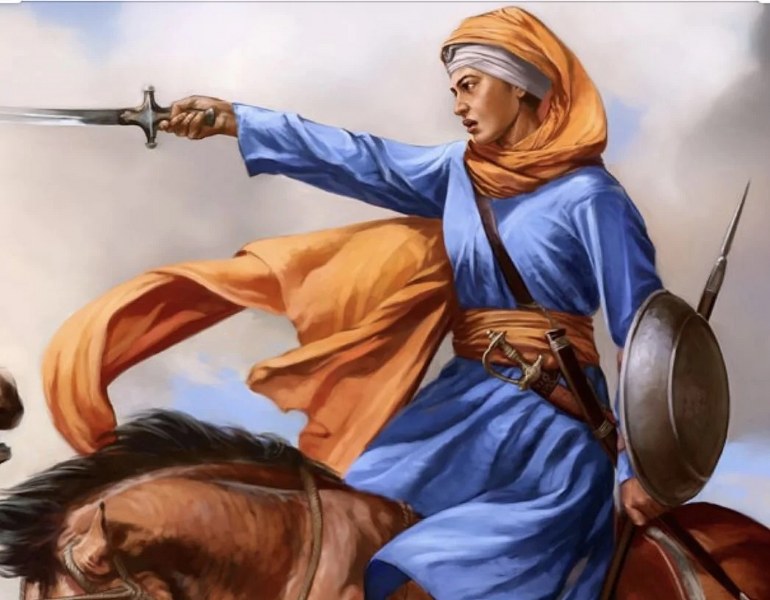 Sikh Warrior
Sikh Warrior
Mai Bhago: Remembering the Sikhni in shining armour against Mughals
Mai Bhago was certainly a warrior – a woman revered in the Sikh community and beyond. Hers is the story of that knight in shining armour who chose her sword to epitomize her unwavering loyalty and devotion towards her faith and her people.
Mai Bhago, born Mata Bhag Kaur, was the lioness of Punjab. In the 17th century, the Indian sub-continent was suffering under the fanatical and oppressive regime of the Mughals. These dark times saw a silver lining in the form of Sikhism which had carved out a safe space where masses believed in equality and were free to practice a faith of their choosing.
Let us take a few more steps back and look through the doors of history. At this time Mughals were ruled by Aurangzeb who was a ruthless tyrant. He imposed discriminatory taxes on Hindus and brought back tough Sharia Laws. He was particularly aggressive towards the Sikhs, majorly because he was against their egalitarian norms which deemed women equal to men.
Thus starts the saga of gallantry displayed by Mai Bhago in the battle of Kidhrana fought on 29th December 1705, between Sikhs led by Guru Gobind Singhji and the mighty Mughal army who came to capture the Guru and put an end to Sikhism.
Although a detailed account of Mai Bhago’s early life is not available, it is known that she was born in the village of ‘Jhabal Kalan’ in Amritsar district (Punjab). She was the only daughter of Bhai Malo Shah and granddaughter of Bhai Piro Shah. The family were ardent followers of Sikhism since the time of Guru Arjan Dev. She was married to Sardar Nidhan Singh Warraich.
Aurangzeb launched a major military campaign against Guru Gobind Singh and sent thousands of troops to fight against a much smaller force of Sikhs. Gradually, the Sikh soldiers died or deserted their army and Guru Gobind Singhji had to retreat into hiding.
Mai Bhago, in the meantime, was getting military training from her father. Being a staunch ‘Sikhni’, she was devastated when she got to know that some of the soldiers from her own village had deserted their Guru. She, then, took matters into her own hand and persuaded them to return to the Khalsa. While these forty fighters and Mai Bhago were on their way to the Guru, they were attacked by the Mughal’s battalion of thousands of soldiers near Anandpur Sahib. The group of Sikhs fought valiantly under the command of Mai Bhago who, in full Khalsa uniform, with a ‘Keski’ tied around her head, plunged head-on in the battle with her ‘kirpan’ in her hand!
Her war cry was, “Waheguruji da khalsa, Waheguruji di fateh.“
She was the lioness of Punjab in the true sense of the word. Although 39 soldiers in her army died in the battle, they emerged victorious as they successfully chased the Mughals away. Only Mahan Singh Brar was barely alive at the time Guru Gobind Singh reached the battleground.
The Khalsa was so impressed with their bravery that he tore the note that he had asked them to sign earlier when they had deserted him, renouncing their religion. He blessed them as “Challi Mukte” or the forty pearls. Mahan Singh eventually died and Mai Bhago was grievously wounded. She was nursed back to health by the Khalsa himself.
Later, the guru asked her to return back to her village as she had lost both her husband and brother in the battle but she requested the Khalsa to reinstate her as a saint-solider so that could stay with the Guru. Her wish was granted and she stayed with him as one of his bodyguards.
Mai Bhago accompanied Guru Gobind Singhji to Nanded and remained at his service till he passed away in 1708. Subsequently, she retired to Jinvara, near Bidar in Karnataka, where she preached Sikhism till she died at a ripe old age. Her hut in Jinvara has now been converted into Gurdwara Tap Asthan Mai Bhago. At Nanded too, a hall within the compound of Takt Sachkhand Sri Hazur Sahib has been marked as the site of her residence known as Bunga Mai Bhago.
Mai Bhago’s legacy lives on to date as a symbol of Sikh pride and bravery. She is often referred to as the “little-known legend” but continues to inspire many brave Sikh women to face death with honour.
Support Our Journalism
We cannot do without you.. your contribution supports unbiased journalism
IBNS is not driven by any ism- not wokeism, not racism, not skewed secularism, not hyper right-wing or left liberal ideals, nor by any hardline religious beliefs or hyper nationalism. We want to serve you good old objective news, as they are. We do not judge or preach. We let people decide for themselves. We only try to present factual and well-sourced news.







